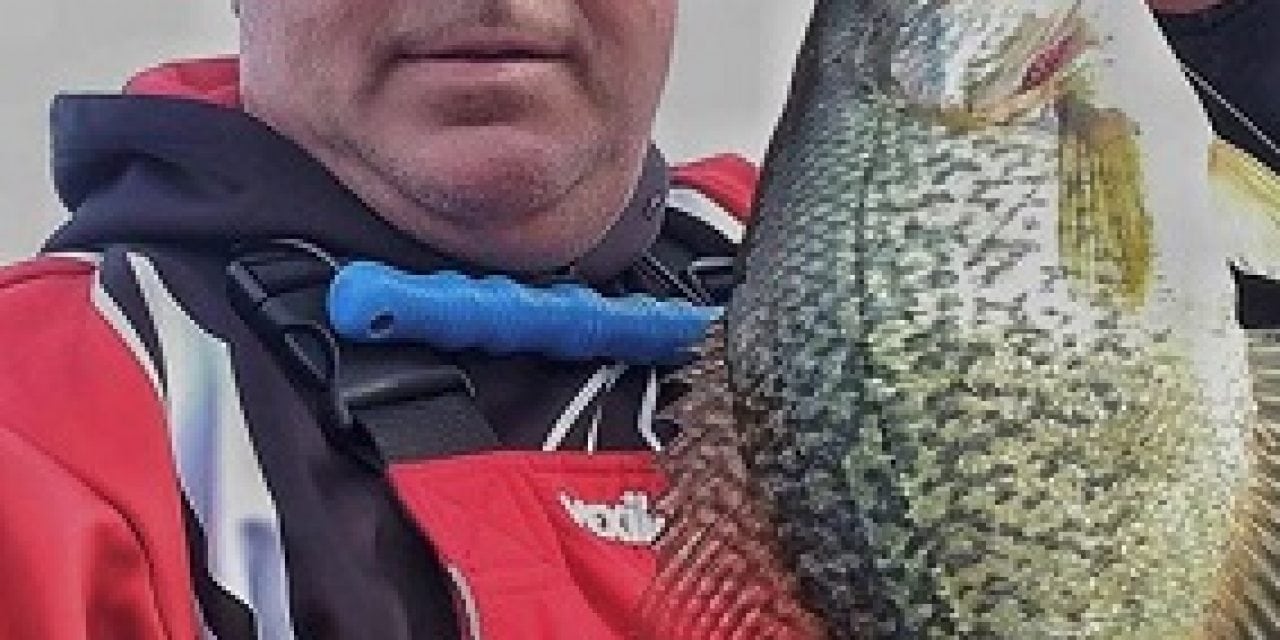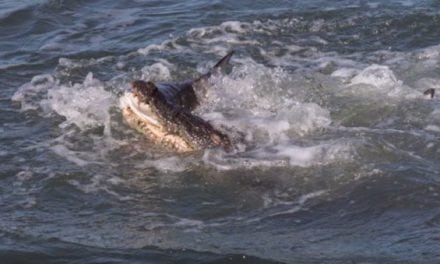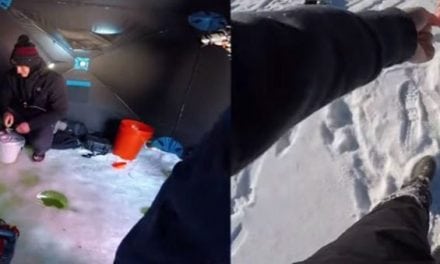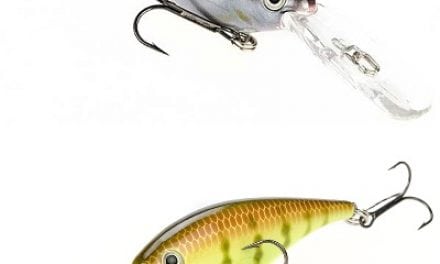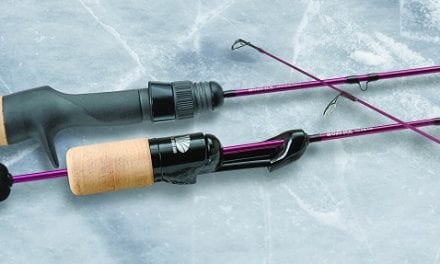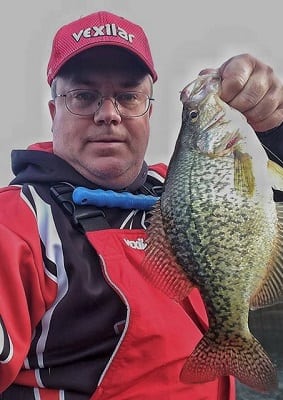 When anglers are interested in catching more fish from under the ice, the use of a Vexilar three-color flasher is considered “essential” by many to your success. Catching fish once you have pinpointed them is easy compared to what you need to know and the amount of effort it takes finding them in the first place.
When anglers are interested in catching more fish from under the ice, the use of a Vexilar three-color flasher is considered “essential” by many to your success. Catching fish once you have pinpointed them is easy compared to what you need to know and the amount of effort it takes finding them in the first place.
The steps to follow in locating fish under the ice is no easy task. Anglers heading out on lakes with little or no ice fishing pressure are in for some plain old hard work. Few anglers relish the challenge of finding fish on a new lake. Most prefer “following the crowds” and let their eyes be their fish finders. To some, going from one group of anglers to another is their form of “recon”. If you ice fish, you may not want to join the crowd or at some time you will be faced with the challenge of being the only angler on the ice, so here are a few tips to remember the next time it happens to you and you want to find fish.

Your first step is to understand the kind of water you are going to fish. This will mean getting a lake map and looking at the types of structure you have available to you at this time of year. Remember, your ability to travel on a lake may be limited to foot power or poor ice conditions may limit the areas you can reach safely. It is always a good idea to know the roads and the various winter access points that surround any given lake.
When it comes to finding fish, every time you try to make rules as to where you SHOULD find fish, the rules change. Like catching sunfish at night, many would agree that sunfish don’t bite at night, but in some lakes, you don’t catch the really big onesuntil the sun goes down…go figure. Here are a few good guidelines to use to begin your search, simply because you will need to start someplace. The more you learn by fishing, the more you can refine the rules that govern the lake you are on that day.
Walleyes love deep, hard bottom areas. Crappies and perch love waters of over 30 feet with a super soft bottom, and sunfish love to hang off steep weedy break lines. Finding the right fish holding elements for the fish you are after is fairly easy with a lake map. If the lake has one deep hole, then you would start there for crappie. If a lake is a maze of structure, then it is best to break the lake into small regions that you can work without getting too confused. Your first goal on most lakes is to establish the edge of the weed line. Most winter lakes get far clearer then they do in the summer, and some of the biggest sunfish in the lake move into the old weed line for protection from predators. Checking the edge of the weed line is even better if you are near a point or inside turn where the deep water comes closest to shore.
Once you embark on a lake, you better come to the realization that drilling holes will be the best way to find out about what is below your feet. When clear ice is available, the transducer from your flasher will be able to transmit a sonar signal right through the ice. To do this, you will need to make sure there is no air between the face of the transducer and the ice. Water is often used to bridge this gap to give you a good sonar connection with the ice. White ice or ice with bubbles will restrict the transmission of the sonar signal; so drilling a hole is the best way to go.
If you’re targeting a break line, a series of holes placed only ten to twenty feet apart heading out from shore will give you a feel for what to expect as you move away from the weed line to find the clean bottom edge. In the weeds, your flasher display will show a great deal of green and orange signals above the bottom red band, even on the lowest gain setting. You will need to keep your gain turned down as low as you can to make sure you find the true bottom in thick weeds, since the weeds themselves could appear as a red signal if the gain is too high. If you fish a great deal in waters under ten feet, you may find your FL-8SE will work best with the aid of an S-Cable or suppression cable, available from Vexilar or a Dealer as an accessory. The S-Cable attaches quickly to your transducer cable where it attaches to the back of your unit. This small cable will reduce the output of your signal by more than 50% to allow you to see through thick weeds to find true bottom. Summer anglers commonly use the “S” cable. The other Vexilar flashers have a special shallow water, or Low Power, mode built-in, so all you need to do is switch into the “LP” mode.

As you move to deeper and deeper waters, the growth of weeds will move tighter and tighter to the bottom. If you are seeing a great deal of flasher signal movement inside the area of weeds displayed as green or maybe even orange flashes moving up and down or coming and going from the display, this may or may not be fish. The display can show fish moving around in the weeds, but don’t be fooled into thinking they are ALWAYS fish. There is a great deal of weed movement under the ice than most anglers realize. As the weeds sway back and forth the green and orange signals will flicker or even seem to move up and down. These moving weed signals will seem to move like fish. To be safe, it is best to drop a line in such situations to see if there are indeed fish inside the weeds. The best technique is to keep your bait a foot or so above the weeds to see if the fish will move above the weeds to feed. Many anglers like to fish two or even three feet above the weeds because you will be able to show the bait to more fish the farther above the bottom your bait is, but water clarity often effects how willing fish are to see and then move great distances to grab your bait. Ice fishing legend Dave Genz loves to fish big bluegills right inside the weeds and has mastered the art of looking for moving targets inside the weed signals. For most anglers, it will take a few trips to identify active fish inside a weed bed, but it can be done. The fewer the weeds you have, the easier it will be to spot targets holding just above the bottom.
 If you’re looking for walleye, many anglers use the same technique to search out the transition edges where the bottom density changes. Contrary to what many might think, you seldom drill a hole and find a school of walleye sitting under your hole. Walleyes love to move along transition edges, like places where rock turns to sand, sand to silt. You may want to move deeper and deeper until you find the transition point where the hard bottom turns to silt. Transition zones can be spotted on your flasher in the same basic way. The harder the bottom, the crisper the bottom red signal will be. To say here in text what you should look for is difficult at best, so take a look at these diagrams. What we have learned to do is compare bottom signals from one area to another. If the bottom signal band is wider and the trailing bottom edge extending farther and farther beyond the back side of the red depth band is one sign of the getting softer, when compared to nearby readings. Softer bottoms will absorb signals and make it harder to get a return signal. A weak signal may even be shown as the bottom turning to orange or even green in mucky bottom areas. It is best to NOT adjust your gain setting when looking for changes in bottom density.
If you’re looking for walleye, many anglers use the same technique to search out the transition edges where the bottom density changes. Contrary to what many might think, you seldom drill a hole and find a school of walleye sitting under your hole. Walleyes love to move along transition edges, like places where rock turns to sand, sand to silt. You may want to move deeper and deeper until you find the transition point where the hard bottom turns to silt. Transition zones can be spotted on your flasher in the same basic way. The harder the bottom, the crisper the bottom red signal will be. To say here in text what you should look for is difficult at best, so take a look at these diagrams. What we have learned to do is compare bottom signals from one area to another. If the bottom signal band is wider and the trailing bottom edge extending farther and farther beyond the back side of the red depth band is one sign of the getting softer, when compared to nearby readings. Softer bottoms will absorb signals and make it harder to get a return signal. A weak signal may even be shown as the bottom turning to orange or even green in mucky bottom areas. It is best to NOT adjust your gain setting when looking for changes in bottom density.
Since you are hoping to catch fish holding on or very near the bottom, you seldom “see” fish on your flasher before you drop a line. This is why you will need to punch holes, lots of holes, and move from hole to hole to pinpoint pockets of fish. You will be surprised how quickly the fish will respond by coming to your bait if you are close to them. Give each hole just a few minutes of fishing time while you watch your sonar for fish interest. When using this technique, the first thing you will notice is that the very top edge of the bottom signal will begin to flicker and even pulsate. On many occasions you will have a small thin green line that sits just above the bottom signal and that green line will start to bounce as the fish approaches your bait. The signal will grow and eventually seem to pop up off the bottom and start to turn orange, then red, as the fish enters the area of your signal directly below your transducer. The fish didn’t suddenly come in from below you, it was a distance away and you attracted them to your bait. Perch are also great for this kind of fish finding and catching technique. When fishing for bottom fish, you will need to do a lot of testing to find areas the fish are really holding in, don’t rely on electronics to “find” your fish. Once you find action, stay of course, but don’t be afraid to move when the fish signals or flickering bottom disappears. The advantage of electronics will be your ability to know if there is fish activity around your bait.
If you are fishing at a time when the fish are moving through the area, you can actually follow the school up or down a break line if you pre-cut your holes along a key migration route. Once the fish signals disappear, the fish often move up or down the break line at key times and that is whenknowledge gained from hole drilling can help. Say you set-up for walleye fishing at three in the afternoon on a point. Your daytime fishing action may take place in thirty feet of water, but as the sun hits the horizon, the fish pull up on the point in only 12 feet of water. By pre-drilling and knowing the bottom contour the fish may travel, you can extend the prime time of fishing catching to a few hours instead of one quick flurry of action.
The mobile hole-jumper really has the edge over the angler who sits and waits for the fish to come to them. After a while, a “pivot area” will develop as a key area for fish to school around, this is where you want to focus your attention. When using your sonar to fish for tight holding walleye, be aware of how large rocks and steep slopes can create a “dead zone” in your area of coverage. If you position your hole near a large boulder, you will find your lure dropping a foot or two below the bottom signal you see on your dial. This is simply a nature of the sonar signal itself being shielded by the shadow created by the rocks you are fishing around. When this condition exists, don’t expect to see many fish when you get a bone jarring strike from a walleye holding tight to the bottom between the rocks. A narrower angler transducer can help reduce this effect if you find yourself in this situation a lot.
One big exception to fishing transition zones on lakes would be fishing for sunfish, crappie and perch on lakes with soft muck bottoms. These “mud lakes” hold an enormous amount of insect life in the soft “muck” bottoms and panfish know it. For this reason, they often school in great numbers over this area of soft bottom.
Finding fish schooling 18 feet down over 35 feet of water is common on many natural lakes with soft bottom areas. The use of your Vexilar flasher will become critical for you to find these nomadic schools of fish that range over these mud areas for most of February and March. Often referred to as “crappie holes” these deep water pockets of soft bottom will hold a large number of crappie and sunfish in the late winter months.
Using your flasher for finding winter panfish is almost a MUST. Seldom will you get into big numbers of panfish unless you are able to actually spot schools on your flasher first. This is where you can really cover some water since your sonar will be your eyes. Many prefer to drill holes even for this type of fishing recon since you are able to increase the gain on your unit to “look” for fish on the edges of your cone signal. Fish targets will appear as green lines randomly coming and going three to ten feet above the bottom. It might even seem like interference to some, or look like weeds to others. We have heard reports of perch schools on Devils Lake ten feet thick! If you are still able to spot these green signals as you turn you gain back down to the one or two setting on your gain, you know the fish are very near you and very likely to respond to a bait as you drop it into the schooling zone. Once you find schools like this, limits of panfish are often not far behind. Aggressive panfish anglers who travel in search of these schools will find their efforts well rewarded.

Once you have pinpointed these schools, it is best to focus your attention on figuring out ways to get these fish to bite. We have already mentioned that we needed to turn the gain back to a more normal setting when you fish. This begins by setting your gain to have your bait show up as a thin red signal on your dial as it drops deeper and deeper. It may be necessary to increase your setting, as you get deeper to keep the lure target red and easy to see. The most popular technique for fishing suspended fish is to stop the bait above the school and “bring the fish to you”. This will be a great example understanding fish signals and how fish are NOT “coming up” to your bait. As in the figure here, a green signal two or three feet below your bait may actually be a fish two or three feet away from the center of the cone, but act the exact same depth as your bait. As the fish comes to your bait, they reduce the distance from the center of the cone and your dial will show this change as a change in depth. The colors of the signals will also change as the fish gets closer to the center of the cone. Since your small ice fly is shown as a red mark, it won’t be long before the fish that was once a small green blip, will change to orange and then to a bright red. Once red, you should be ready for a bite. Like a video game, the fish will react to your lure action or bait offering and you can adjust your angling techniques to put more fish on the hook. This is one of the big advantages of using a Vexilar flasher. You are able to better understand the interest level of the fish and become a much more successful angler because of what you will learn.
As you head out on a lake in search of fish under ice, remember to keep an open mind, a full tank of gas in your ice auger and a watchful eye on what your electronics are telling you. Think of it as an adventure, a challenge and a great winter workout.
Don’t have a Vexilar Flasher? Get one at a dealer near you.
The post Finding Fish Under the Ice With Your Flasher appeared first on ODU Magazine-North America's #1 Digital Fishing Magazine.

